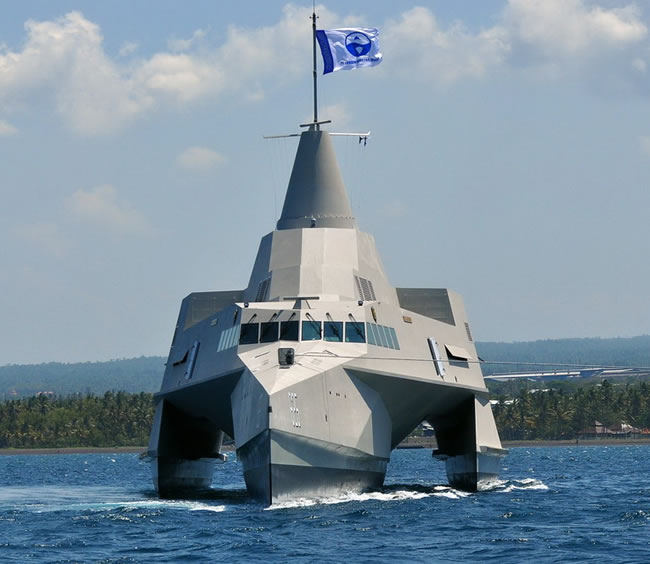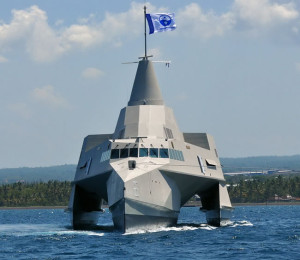

North Sea Boats launched the first of four advanced, stealthy, 63 meter trimaran patrol boats for the Indonesian Navy on August 31, 2012. Following the completion, extensive sea trials and testing commencing next month, the KRI KLEWANG is is expected to be fully operational 2013. All four vessels are scheduled for delivery by 2014.
Unfortunately, Klewang was destroyed by a fire tree weeks after its launching, while moored at the naval port in Banyuwangi, East Java for maintenance. No casualties have been reported but the new vessel was lost.
The new vessel to be named KRI Klewang (after a traditional Indonesian single edged sword) was launched at Banyuwagni, in Indonesia. Following the official launching the vessel will be fitted with mission systems and weapons, including a remotely controlled gun turret and anti-ship missiles. The four vessels are built at the PT Lundin shipyard in East Java.
[nonmember]Premium subscribers can read the full version of this article, including the new photo gallery. Interested?[/nonmember]
[ismember]The ship designer, New Zealand based LOMOcean employed the wave-piercer trimaran hull form, providing external “Stealth” geometry and additional features intended to reduce detection. This hull offers high stability and shallow draft (only 1.2 meters), preparing the vessel for its main mission – patrolling the littorals.
The hull shape is intended to permit high speeds to be maintained and thus maximize crew operational capability in the short, steep seas characteristic of the coastline around the Indonesian Archipelago. The design borrows elements from previous trimarans from the same designer, including the 24m Earthrace (later Ady Gil), holder of the record for the fastest circumnavigation of the globe by a power boat. The vessel is constructed exclusively of infused vinylester carbon fibre cored sandwich materials for all structural elements. According to the builder, Klewang represents the first use of these composite materials in such a large scale, with a military vessel. However, The fire which razed Klewang in two hours burning the boat down to the waterline should have the shipbuilder and Indonesian navy question the survivability of this class of boat and suitability of its supposedly fire retardant composite-made construction for military use (the boat is made of PVC, Carbon Fiber and other composites). Naval vessels are commonly made of steel, considered more durable to damage and fire. Smaller boats are also made of aluminium which has also proved more vulnerable to fire.
As laminated carbon fibre has a density nearly half that of aluminium alloys, the new construction method offers reduced weight and reduced maintenance, since carbon composites do not corrode as metals, and exhibit extremely high fatigue limits. Moreover, the hull and superstructure can be tailored to minimize radar cross section, with finishing providing true flat panel geometry and extremely high geometrical accuracy, attained without the seams typical conventional assembly. The composite structure has no magnetic signature, and its thermal and acoustic signatures are also reduced.
The underwater sections have been optimized for extended range at fast patrol speeds; the length, transverse and longitudinal positions and immersion of each of the three hulls have been carefully tailored for least resistance using both slender body analysis and towing tank testing.
[wzslider autoplay=”true” info=”true”][/ismember]
The vessel is powered by four MAN V12 diesel engines, driving multiple MJP 550 water jets, located on the three for maximum propulsive thrust and maneuverability. The vessel can develop a ‘sprinting’ maximum speed of 35 knots. Cruising speed is 16 knots and the stated operational range is over 2000 nautical miles.
The Klewang is armed with concealed gun turret, missile launchers and small arms posts. Trimarans offer very stable weapons platforms, and can carry various Missile systems; including Type 705 (up to 8), RBS15, Penguin or Exocet, and 40-57mm Naval Guns, or a CIWC (Close In Weapon System). These can be mounted high on the superstructure, giving better range and firing arc. Sensors can also be installed high up without concerns for stability. This first ship will carry a turnkey system delivered by CSOC and CPMIEC China, including rapid fire CIWS, combat control and missile systems. The exact configuration of this system is still classified.
Accommodation is provided for a complement of twenty nine (officers and crew) on three internal decks (including bridge and combat control centre), with facilities and equipment also provided for deployment of special forces troops, including an 11m high speed 50 knot RIB, also manufactured and supplied by North Sea Boats.
















